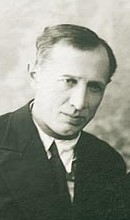Biography:Nikolai Chebotaryov
Nikolai Chebotaryov | |
|---|---|
 | |
| Born | 15 June 1894 Kamianets-Podilskyi, Russian Empire (modern-day Ukraine ) |
| Died | 2 July 1947 (aged 53) |
| Nationality | Soviet Union |
| Alma mater | Kiev State University |
| Known for | Chebotarev's density theorem |
| Scientific career | |
| Fields | Mathematics |
| Institutions | Kazan State University |
| Doctoral advisor | Dmitry Grave |
| Doctoral students | Mark Krein Naum Meiman |
Nikolai Grigorievich Chebotaryov (often spelled Chebotarov or Chebotarev, Ukrainian: Мико́ла Григо́рович Чеботарьо́в, Russian: Никола́й Григо́рьевич Чеботарёв) (15 June [O.S. 3 June] 1894 – 2 July 1947) was a Soviet mathematician.[1] He is best known for the Chebotaryov density theorem.[2]
He was a student of Dmitry Grave, a Russian mathematician.[3] Chebotaryov worked on the algebra of polynomials, in particular examining the distribution of the zeros. He also studied Galois theory and wrote a textbook on the subject titled Basic Galois Theory. His ideas were used by Emil Artin to prove the Artin reciprocity law.[4] He worked with his student Anatoly Dorodnov on a generalization of the quadrature of the lune,[5] and proved the conjecture now known as the Chebotaryov theorem on roots of unity.
Early life
Nikolai Chebotaryov was born on 15 June 1894 in Kamianets-Podilskyi, Russian Empire (now in Ukraine ). He entered the department of physics and mathematics at Kyiv University in 1912. In 1928 he became a professor at Kazan University, remaining there for the rest of his life. He died on 2 July 1947. He was an atheist.[6] On 14 May 2010 a memorial plaque for Nikolai Chebotaryov was unveiled on the main administration building of I.I. Mechnikov Odessa National University.[7]
References
- ↑ O'Connor, John J.; Robertson, Edmund F., "Nikolai Grigorievich Chebotaryov", MacTutor History of Mathematics archive, University of St Andrews, http://www-history.mcs.st-andrews.ac.uk/Biographies/Chebotaryov.html..
- ↑ Lenstra, H. W.; Stevenhagen, P. (1996), "Chebotarëv and his density theorem", Mathematical Intelligencer 18 (2): 26–37, doi:10.1007/BF03027290, http://websites.math.leidenuniv.nl/algebra/chebotarev.pdf.
- ↑ Nikolay Grigorievich Chebotarev at the Mathematics Genealogy Project
- ↑ http://websites.math.leidenuniv.nl/algebra/artin.pdf [bare URL PDF]
- ↑ Postnikov, M. M. (2000), "The problem of squarable lunes", American Mathematical Monthly 107 (7): 645–651, doi:10.2307/2589121. Translated from Postnikov's 1963 Russian book on Galois theory
- ↑ https://www.ams.org/notices/201401/rnoti-p62.pdf [bare URL PDF]
- ↑ "Chebotaryov, Nikolai Grigorievich." Complete Dictionary of Scientific Biography. 2008 - http://www.encyclopedia.com/doc/1G2-2830900875.html
 |

